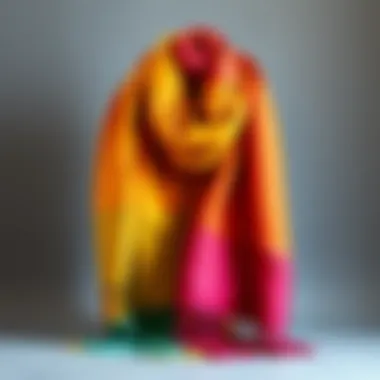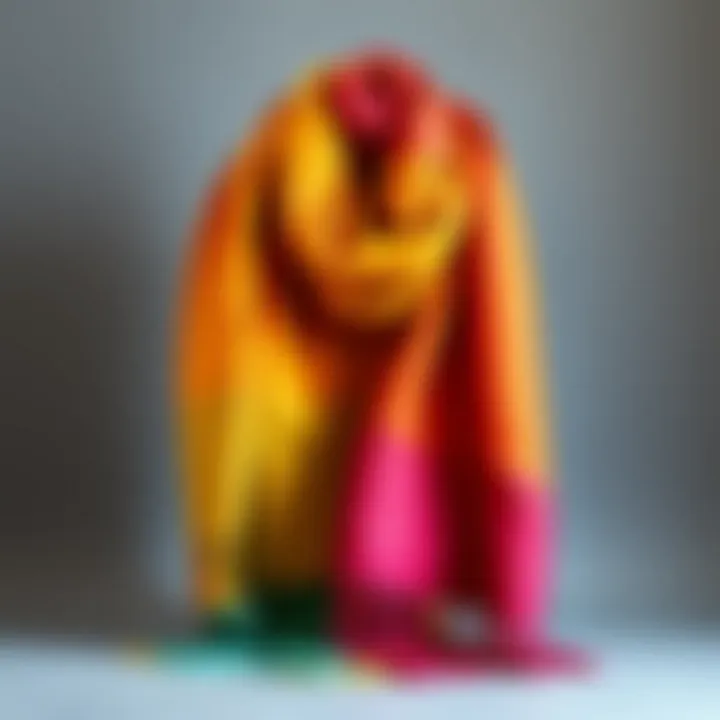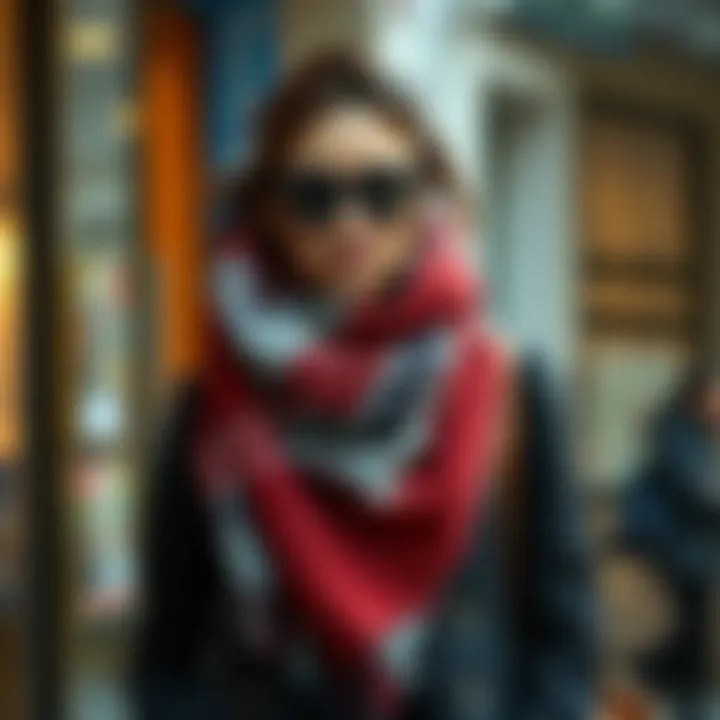Discovering the Allure of Pashmina Blanket Scarves


Intro
Pashmina blanket scarves are more than just a cozy accessory; they tell a story steeped in tradition, culture, and craftsmanship. Sourced from the fine wool of the Changthangi goat, these scarves boast an intricate history that stretches back centuries. Renowned for their softness and warmth, they have evolved from simple garments into versatile pieces that can elevate any outfit. With their rich hues and exquisite patterns, pashmina blanket scarves have captured the hearts of fashion enthusiasts and everyday wearers alike. In this exploration, we'll dive into the remarkable qualities of pashmina, practical styling tips, and essential care methods to help you fully appreciate this luxurious item.
Fabric Knowledge
Types of Pashmina Fabrics
Pashmina is not just a fabric; it's a blend of art and science. Generally, it's categorized into a few primary types:
- Pure Pashmina: This is the gold standard, harvested from the undercoat of the Changthangi goat. It's incredibly fine, light, yet warm, making it perfect for chilly weather.
- Pashmina Blend: Often mixed with silk or cotton, these blends can add strength or a different feel to the fabric. While they may not carry the same purity, they can be more affordable and still maintain a soft touch.
- Cashmere: Though technically different, cashmere scarves often feature similar properties. Cashmere can be a bit thicker and less forgiving in terms of price.
Understanding these distinctions is pivotal. When selecting a scarf, a pure pashmina holds up both in luxury and longevity, but blends might offer more affordability and practical wear for the daily grinder.
How to Care for Different Fabrics
Keeping your pashmina in peak condition requires understanding its delicate nature. Here are some quick care tips for various types of pashmina fabrics:
- Washing: Always opt for hand washing with cool water. Use a gentle wool detergent; avoid fabric softeners, as they can damage fibers.
- Drying: Lay flat on a clean towel to dry. If you hang it, that can lead to stretching.
- Storage: Keep them in breathable cotton bags to prevent dust accumulation. Avoid hanging them; it’s best to fold them neatly.
"Caring for your pashmina is just as crucial as choosing the right one. A little care goes a long way in extending the life of this exquisite accessory."
Style Tips
Outfit Pairing Strategies
A pashmina blanket scarf can transform your look from drab to fab in no time. Here are some effective strategies:
- Layering: Drape it over a fitted turtleneck or sweater. The contrast brings balance and flair.
- Belt It: For a chic silhouette without compromising warmth, try belting your scarf over a dress or long cardigan.
- Casual Chique: Pair it with a crisp white shirt and tailored jeans. This adds an effortlessly polished look; you can dress it up or down.
Seasonal Fashion Trends
As fashion evolves with seasons, so do ways to style pashmina scarves. For winter, think oversized wraps that double as light shawls. In spring, opt for pastel hues to match blooming flowers. During autumn, deeper colors and thick wraps can mimic the warm tones of falling leaves.
- Winter: Opt for rich, deep colors like burgundy or navy. Go for larger wraps that can act as both scarf and shawl.
- Spring: Light pastels and floral patterns come alive this season, offering a refreshing feel.
- Autumn: Capture the season with earthy tones and heavier fabrics, which can add both color and warmth.
Being aware of these seasonal shifts can help you style your pashmina scarf effectively, making it a staple piece in your wardrobe.
For more in-depth knowledge on pashmina, check out resources like Britannica, or explore community discussions on Reddit for unique styling ideas.
Embracing the pashmina blanket scarf isn't just about fashion; it's about celebrating a rich legacy while making it relevant in modern style.
Understanding Pashmina
The significance of understanding pashmina goes far beyond its mere aesthetic appeal. Pashmina is a fiber renowned for its softness, warmth, and luxurious feel, making it a staple in high-end fashion. Recognizing what pashmina is and its rich history provides a context for appreciating the craftsmanship that goes into every scarf. This knowledge not only enhances the value of the piece itself but also deepens the connection between the wearer and the cultural heritage it represents.
Definition and Origin
Pashmina originates from the Persian word "pāshm", which means "soft gold". This term itself adequately reflects the rare quality that characterizes pashmina wool. It is derived from the undercoat of the Changthangi goat, a breed found in the high altitudes of the Himalayas, particularly in regions of Nepal, India, and Pakistan.
Historically, pashmina has been woven in Kashmir for centuries. It was the fabric of choice for royalty, often used in shawls that adorned emperors and dignitaries. The nuanced art of weaving pashmina has been passed down through generations, and every handmade piece tells a story that blends tradition with modernity.
Cultural Significance
In many cultures, pashmina represents more than just a luxurious textile; it embodies a legacy. It is a symbol of status and refinement, often gifted during important life events such as weddings or significant birthdays. In regions like Kashmir, the craft of pashmina weaving is not just a profession but a revered societal role, integral to local identities. The uniqueness of each pashmina piece can vary depending on the region of production, lending a distinct flavor to the fabric's cultural narrative.


The vibrant colors and intricate designs often reflect the natural surroundings or the spiritual beliefs of the artisans, making each scarf a wearable work of art. Moreover, pashmina's importance in festivals and other ceremonies highlights its role in celebrating heritage. In essence, wearing a pashmina blanket scarf is not just a style statement; it connects the wearer to centuries of cultural history.
Types of Pashmina Wool
Not all pashmina wool is created equal. The quality can vary significantly based on the breed of the goat, the region of production, and the methods used in processing. Here are the main types:
- Cashmere: This is the finest wool, often sourced from the Changthangi goats.
- Pashmina: Slightly coarser than cashmere but still possesses remarkable warmth and softness.
- Mixed Wool: Some products combine pashmina with sheep wool or synthetic fibers to reduce costs or enhance durability. While these can still be lovely, they lack the luxurious attributes of pure pashmina.
To appreciate a pashmina blanket scarf fully, one must consider the source and methods of weaving, as these factors contribute heavily to the fabric's appeal and functionality.
"Understanding pashmina is not just about fashion; it's about honoring a rich tradition that connects us to our past."
The Pashmina Blanket Scarf: A Functional Accessory
In an evolving world where fashion meets functionality, the pashmina blanket scarf firmly holds its ground as a versatile accessory. Often overshadowed by standard scarves, blanket scarves bring a lot more to the table. Their multifunctional nature allows them to double as cozy wraps, statement pieces, or even casual throws that spice up both wardrobes and spaces. By examining various facets of this accessory, one can appreciate how a pashmina blanket scarf is not just an item of clothing but an essential part of style without sacrificing comfort.
What is a Blanket Scarf?
A blanket scarf is not your average piece of fabric. It’s typically oversized, often measuring about 55 inches or more on each side, allowing for greater versatility. Traditionally crafted from soft fibers like pashmina, these scarves provide warmth akin to a blanket, hence the name. When draped over the shoulders or wrapped around the neck, they offer a significant layer of coverage, suitable for various climates.
Moreover, blanket scarves come in diverse patterns and colors, which allows individuals to express their personal style. Whether one opts for a classic tartan design or a bold, modern print, there’s no shortage of options. During colder months, a pashmina blanket scarf can serve as an additional layer during evening outings, or it can simply provide warmth while lounging on the couch.
Difference Between a Scarf and a Blanket Scarf
While scarves have a distinct drapey elegance, the difference between them and blanket scarves lies primarily in dimensions and functionality. Regular scarves tend to be narrower and longer, designed mainly for warmth around the neck without much versatility. In contrast, here are some distinguishing features:
- Size: As mentioned earlier, blanket scarves are larger and can easily envelop the body, while scarves are modest in length.
- Material: Blanket scarves commonly utilize thicker materials, often wool or cashmere blends, to provide substantial warmth, whereas regular scarves may feature lighter fabrics.
- Use Cases: A scarf is usually worn primarily for warmth, whereas a blanket scarf can serve multiple purposes, from appearing as a stylish accessory to acting as a makeshift blanket when needed.
The variety in these elements speaks to the functional advantage of blanket scarves—especially those made with exquisite pashmina wool.
Benefits of Pashmina Blanket Scarves
Integrating a pashmina blanket scarf into one’s wardrobe comes with a slew of benefits. Let’s delve into what makes these accessories a must-have:
- Exceptional Warmth: Made from fine pashmina wool, these blanket scarves can retain heat remarkably well. The natural insulating qualities ensure comfort without adding bulk.
- Versatility: They can be styled in numerous ways—draped, tied, or wrapped. This means one piece can be worn differently for various occasions, from casual outings to formal gatherings.
- Stylish yet Practical: With their array of designs, tthey don’t merely function as a source of warmth. They can elevate an outfit, making a statement about personal style.
- Lightweight: Despite offering warmth akin to a traditional blanket, the quality of pashmina makes them surprisingly lightweight, allowing for easy portability.
In essence, the pashmina blanket scarf stands out not just as a functional accessory but as a creative element that brings fashion and practicality together in an exquisite package. As you continue this exploration of pashmina blanket scarves, it’s evident that understanding their versatility adds depth to any wardrobe.
Styling Pashmina Blanket Scarves
Styling pashmina blanket scarves is a vital topic to discuss, as it encapsulates the versatility and elegance that these accessories can bring to various outfits. Understanding how to properly drape and wear pashmina can elevate one's fashion game significantly. When chosen wisely, a pashmina blanket scarf can transition seamlessly through seasons and occasions, making it an invaluable part of any wardrobe. Therefore, exploring different styling options only enhances a person's overall aesthetic. Let's delve deeper into some specific aspects of styling.
Draping Techniques
Draping a pashmina blanket scarf effectively can transform its appearance and the wearer's look. Here are several techniques to consider:
- Classic Loop: Drape the scarf around the neck and let both ends hang down. This is simple yet chic.
- Over-the-Shoulder: Place one end across the shoulder and let it cascade down the back. This gives a casual feel while keeping the front stylish.
- Belted Style: Wrap the pashmina around the body and cinch it with a belt, turning it into a somewhat jacket-like accessory. This can highlight curves nicely.
- Knot Front: Twist the two ends together and tie them in a knot at the front, creating a snug and cozy look.
These techniques, while straightforward, can dramatically enhance an outfit, showcasing creativity. Each method offers a unique flair, emphasizing the wearer’s personality and fashion sense.
Casual Versus Formal Wear
Pashmina blanket scarves are incredibly adaptable, serving well in both casual and formal settings. For casual occasions, pairing a soft plaid pashmina with a simple t-shirt and jeans can provide warmth without sacrificing style. On the other hand, when it comes to formal wear, a silk-hemmed solid-colored pashmina over an evening gown can elevate the overall look. The key is to consider the fabric and pattern when deciding how to style it. Casual patterns can offer relaxed charm, while solid, sleek designs work beautifully for more upscale events.
Color Coordination and Patterns
Color coordination plays a significant role in styling a pashmina blanket scarf successfully. When selecting what to wear, consider a color wheel. Complementary colors not only pop but also create a well-rounded look. For instance, a rich burgundy pashmina scarf paired with a beige coat can create a warm atmosphere, while a monochrome palette can convey sophistication.


Patterns also offer an exciting way to express personal style. Stripes, florals, or geometric shapes can add visual interest. However, one must pair patterns thoughtfully. A bold pattern works best with solid colors, allowing the scarf to be the center of attention without overwhelming the entire outfit.
Layering with Other Fabrics
Layering fabrics with a pashmina blanket scarf can create depth and texture. Pairing it with wool or denim jackets adds warmth, while silk blouses give an added touch of luxury. It’s important to remember that the weight and texture of fabrics can affect how well they layer with a pashmina. For instance, combining a thick knitted sweater with a lighter pashmina can provide comfort without feeling too bulky.
Moreover, mixing different textures—like a cashmere sweater with a pashmina scarf—can create a sophisticated yet cozy ensemble. The balance between cozy and stylish is crucial when layering, allowing the whole outfit to remain inviting yet polished.
Closure
Mastering the art of styling a pashmina blanket scarf enhances its expressiveness in fashion. Understanding the various draping techniques, knowing the distinction between casual and formal wear, coordinating colors deftly, and layering with other fabrics all work together to maximize the potential of this luxurious accessory. The right pashmina, styled correctly, can become more than just an item of warmth—it can be a statement piece, showcasing the uniqueness of the wearer.
Choosing Quality Pashmina Blanket Scarves
When diving into the world of pashmina blanket scarves, choosing quality becomes a pivotal focus, as it heavily influences both the experience and longevity of the product. From style to comfort, the fabric’s authenticity plays a significant role in how one enjoys this versatile accessory. Not only do high-quality pashmina scarves elevate one’s outfit, but they also represent a wise investment if you keep a few key aspects in mind.
Identifying Authentic Pashmina
The journey starts with understanding what classifies as authentic pashmina. Genuine pashmina wool is exclusively obtained from the undercoat of Changthangi goats, which are found deep in the Himalayan region. Typically, the finer the fibers, the luxuriously softer the material will be. To identify authentic pashmina:
- Feel: Genuine pashmina feels incredibly soft and silky to the touch. If it feels prickly or synthetic, you’re likely dealing with a counterfeit.
- Burn Test: A small segment can be burned; real pashmina will combust swiftly, producing a smell akin to burnt hair, whereas synthetic materials will melt and emit a chemical scent.
- Labeling: Look for transparent labeling detailing the fiber content. It should specify that it’s made from pure pashmina.
As the demand increases, so does the number of impostors. Being vigilant about these indicators ensures you make an informed purchase.
Price Factors
Price is often a big indicator of quality when it comes to pashmina blanket scarves. The old adage, "you get what you pay for," holds true in this domain. Authentic pashmina tends to carry a higher price tag for several reasons:
- Sourcing: The labor involved in harvesting the fibers is labor-intensive. The goats can only produce a limited amount of wool, which contributes to higher costs.
- Quality Control: High-quality pashmina goes through stringent checks to ensure it meets quality standards.
- Design and Craftsmanship: Exquisite patterns or handwoven designs can also elevate the price.
Investing in a quality pashmina scarf often means paying a premium, but this guarantees you’re less likely to need replacement soon after.
Evaluating Craftsmanship
When it comes to pashmina, craftsmanship is paramount. Each scarf tells a story of the artisan involved in its creation. A few pointers for assessing craftsmanship include:
- Stitching: Examine the edges of the scarf. Neat, tight stitching is an indicator of quality production. If the edges are fraying or poorly finished, it's a red flag.
- Weight: A well-crafted pashmina should have a weight that feels substantial yet still light enough to drape comfortably.
- Patterns: Handwoven scarves often feature intricate designs that can include local cultural motifs. Look for uniformity in patterns and colors; inconsistencies can indicate mass production.
In summary, discerning quality pashmina blanket scarves entails a detailed assessment of authenticity, price relevance, and craftsmanship. These factors provide the skeleton for making informed decisions that lead to a rewarding purchase, aligning with both aesthetic desires and practical use.
Remember: A quality pashmina scarf is not merely an accessory; it's a blend of art, heritage, and comfort, deserving of thoughtful consideration.
Caring for Your Pashmina Blanket Scarf
Caring for your pashmina blanket scarf is crucial not only to maintain its luxurious appearance but also to extend its lifespan. Investing in a high-quality pashmina should come with a commitment to its upkeep. After all, these scarf-cum-blankets aren't just a piece of fabric—they are a blend of tradition, craftsmanship, and delicate material that can last a lifetime if properly cared for. Let's break this down into three key areas: washing techniques, storage recommendations, and repairing damage.
Washing Techniques
When it comes to washing your pashmina blanket scarf, it’s important to approach it with caution. The fibers are incredibly fine and can lose their integrity if not treated gently. Here are some recommended washing techniques:
- Hand Washing: The best way to clean your pashmina is by hand. Fill a basin with cold water and add a few drops of mild detergent. Gently agitate the water to distribute the soap, then immerse the scarf. Avoid scrubbing; instead, swish it around lightly.
- Avoid Soaking: Keep it brief—just a few minutes of gentle cleaning is enough. Prolonged soaking can weaken the fibers.
- Rinse Carefully: After washing, rinse thoroughly with cold water. Make sure all soap is removed, as residue can damage the scarf over time.
- Do Not Wring: Instead of wringing it out, lay the scarf flat on a clean towel and roll it up to absorb excess water. This helps maintain the shape and structure of the fabric.
Using these techniques ensures that your pashmina remains soft and retains its beautiful drape.
Storage Recommendations


Storing your pashmina blanket scarf properly is as crucial as washing it. Improper storage can lead to creasing, discoloration, or even damage from pests. Here are some smart storage tips:
- Flat Storage: Ideally, store your scarf flat, whether in a drawer or on a shelf. This avoids any folding creases caused by hanging. If flat storage isn’t possible, consider a padded hanger.
- Protect from Light: Direct sunlight can fade the colors over time. Choose a cool, dark place for storage to keep it looking vibrant.
- Keep it Clean: Ensure the scarf is completely dry and clean before storing it away. Any trapped moisture can encourage mold growth.
- Use Storage Bags: Place your scarf in a breathable cotton or silk storage bag to protect it from dust. Avoid plastic bags as they can trap moisture.
Following these guidelines will help keep your pashmina looking its best for years to come.
Repairing Damage
Despite all efforts to care for your pashmina blanket scarf, sometimes damage can occur. Whether it’s a pulled thread or a small tear, timely repairs can prevent further issues. Here are some strategies:
- Inspect Regularly: Routinely check your scarf for any signs of wear or damage. Early detection can make repairs much easier.
- Use a Needle and Thread: For small rips, a fine needle and thread can work wonders. Match the thread color to blend in with your scarf. Take your time, and use small, even stitches to maintain the integrity of the fabric.
- Consult a Professional: If the damage is extensive—like significant unraveling or large tears—consider seeking help from a professional tailor. They can perform more intricate repairs without compromising the quality of your scarf.
"Proper care is not just about cleaning; it's about preserving the artistry behind pashmina scarves."
In summary, caring for your pashmina blanket scarf involves thoughtful washing techniques, careful storage, and prompt repair. Pay attention to these aspects and you will ensure that your scarf remains a cherished accessory for many seasons.
The Environmental Impact of Pashmina Production
The production of pashmina is intertwined with environmental considerations that demand careful thought. Understanding these factors is essential for consumers and industry players alike as they play a significant role in the broader conversation about sustainable fashion. Not only does this knowledge empower shoppers to make educated choices, it also encourages producers to adopt practices that may lessen their ecological footprint. Without a doubt, awareness of the environmental impact of pashmina production is critical to navigating the contemporary fashion landscape.
Sustainable Practices
Sustainable practices in pashmina production often begin with animal welfare and land management. Goat herders, primarily in the Himalayan regions of India, Nepal, and Tibet, have adopted methods that prioritize the health of their herds and their habitat. Many local communities implement rotational grazing to prevent overgrazing, allowing pastures to regenerate.
- Organic Farming Techniques: Some producers utilize organic methods to maintain sustainable herding practices. By forgoing synthetic pesticides and fertilizers, the health of the goats and the land are preserved.
- Natural Dyes: Choosing natural dyes instead of synthetic options can significantly lessen water pollution, ensuring that water resources stay clean for years to come.
- Hand-Weaving Tradition: Hand-weaving is still a common technique which not only uses minimal energy compared to machines but also supports traditional artisanal skills.
By promoting such sustainable practices, the pashmina industry can maintain a balance between heritage and modernity, preserving both cultural significance and environmental integrity.
Ethical Sourcing
Ethical sourcing is another cornerstone of responsible pashmina production. This means ensuring that the pashmina wool is obtained without exploitation of the local communities or harming the goats. Consumers should ask questions about how the material they are purchasing is sourced.
- Support Local Communities: Purchasing from cooperatives or organizations that directly benefit shepherding communities can foster economic development while respecting cultural traditions.
- Traceability: Some brands focus on transparency, allowing buyers to trace the origins of their products. This knowledge assures consumers of the ethical treatments involved in bringing pashmina from pasture to fabric.
- Fair Trade Certifications: Look for fair trade labels that certify that the producers meet specific social, environmental, and economic standards.
Securing ethically sourced pashmina not only enriches the product's story but also enhances its value through conscious consumerism.
Consumer Responsibility
As consumers, we hold the power to influence the pashmina market. By making conscious choices, we can advocate for sustainable practices and ethical sourcing. Here are some responsibilities to consider:
- Research Before Purchasing: Spend a little time to research brands and their sourcing practices. Support those that demonstrate commitment to sustainability and ethical production.
- Invest in Quality: Instead of buying cheap, mass-produced pashmina, invest in quality pieces that are likely to last longer. The shorter lifespan of fast fashion contributes to waste and environmental problems.
- Spread Awareness: Share knowledge about the pashmina production process with peers. Awareness can directly impact purchasing choices and expectations of brands.
- Advocate for Sustainability: Engage in conversations and initiatives that promote sustainable practices within the fashion industry. Your voice matters.
By taking these steps, consumers can significantly reduce the environmental impact associated with pashmina production, as well as uplift the communities that rely on it.
The way forward in the world of pashmina lies in a collective effort—producers practicing sustainable methods, and consumers making informed choices. Together, these actions can pave the way for a more responsible fashion industry, ultimately protecting the delicate balance of our environment.
Ending
In wrapping up our detailed discussion on pashmina blanket scarves, it's essential to underline just how significant these textile treasures are within both the realms of fashion and culture. Initially crafted from the fine wool sourced from the Changthangi goats of the Himalayas, these scarves offer far more than warmth; they are a statement, a blend of art, history, and utility.
This journey through pashmina has emphasized various elements such as their luxurious quality, versatility, and the myriad of ways they can be styled. Pashmina blanket scarves serve not only to enhance one's wardrobe but also to express personal style. They fit seamlessly into multiple contexts, from a casual outing to a formal gathering, adapting to the wearer's mood. The benefits of investing in a quality pashmina blanket scarf cannot be overstated, as it promises durability and a timeless aesthetic that transcends fleeting fashion trends.
Moreover, the cultural significance of pashmina is invaluable. Beyond their aesthetic appeal, these scarves embody centuries of craftsmanship and carry the stories of the artisans behind them. It’s vital for consumers to understand the ethical implications of their purchases, especially in an era that increasingly values sustainability and responsible sourcing.
Thus, every step of the way, from selecting an authentic piece to ensuring its proper care, enhances the user's experience and appreciation of this luxurious item. Pashmina blanket scarves are not merely accessories; they are a symbol of a rich cultural heritage and an investment in quality and style. By weaving together the practical with the picturesque, these scarves stand out as a staple piece in modern fashion.
Summary of Key Points
- Definition and Origin: Pashmina refers to a special type of cashmere sourced from the Himalayas, known for its softness and warmth.
- Cultural Significance: These items hold deep cultural value, reflecting traditional artistry and the heritage of the communities that produce them.
- Functional Accessory: A pashmina blanket scarf functions both as a scarf and a blanket, helping to keep the wearer warm in various situations.
- Quality Choice: Understanding how to identify authentic pashmina and recognizing craftsmanship quality is vital for making informed purchases.
- Care and Sustainability: Proper care and knowledge of environmental impacts underline the responsible ownership of such exquisite pieces.
Final Thoughts on Pashmina Clothing
As we stand at the intersection of tradition and contemporary fashion, pashmina blanket scarves remind us of the delicate balance between heritage and modern style. Their versatility allows for endless creativity in outfit choices, catering to diverse tastes and preferences. Choosing the right style, color, and fabric quality can transform how one views and utilizes pashmina. Furthermore, with a growing emphasis on sustainable fashion, choosing pashmina not only reflects an appreciation for quality but also supports ethical practices in textile production. Investing in a pashmina blanket scarf is not just about enhancing one's wardrobe but making a thoughtful decision that resonates with cultural appreciation and personal value. The future of pashmina fashion looks promising, as more people become aware of its legacy and embrace the elegance that comes with such a timeless accessory.















